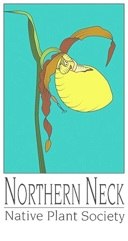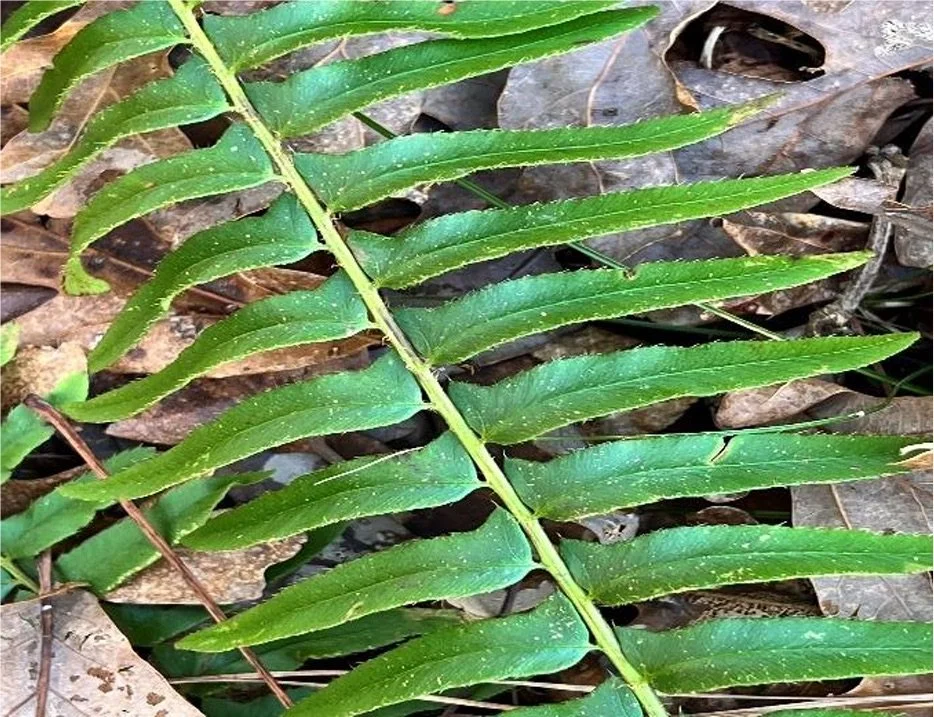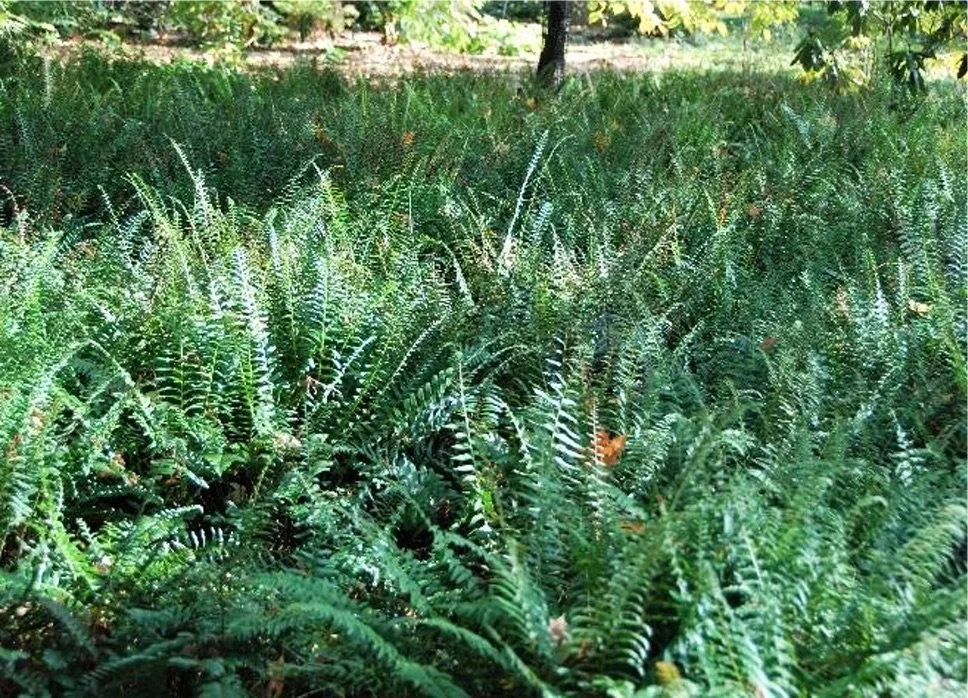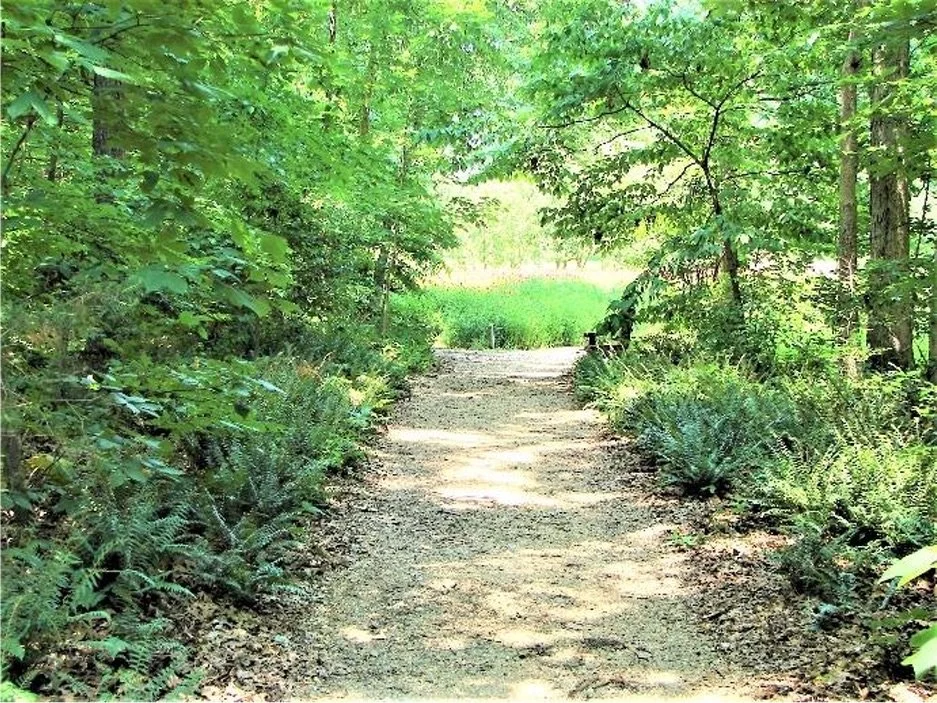Plant of the Month January 2022: Christmas Fern
Christmas Fern, Polystichum acrostichoides
Northern Neck Chapter, Virginia Native Plant Society
January 2022 Plant of the Month
By Betsy Washington
Christmas Ferns grow in handsome vase-shaped clumps
Detail of fern frond
Our deciduous woods are graced by many native ferns, but in winter the evergreen Christmas Fern, Polystichum acrostichoides, takes center stage. It literally lights up the woods with its rich green, lustrous foliage that catches the low-angled winter sun, adding sparkle and color. Christmas Ferns are one of the most common ferns in the Southeast and occur in every county in Virginia. They are extremely adaptable, tolerant of the heat and humidity of the Deep South as well as the cold and ice of northern hardwood forests, ranging from New Brunswick to Northern Florida and west to the Plains. They are found in a diverse array of habitats from stream banks to steep forested slopes and ravines in both dry and mesic forests and in both acidic and neutral soils. Christmas ferns often form extensive colonies on steep slopes and banks, where their fibrous roots hold the soil.
The foliage of Christmas Fern forms a vase-shaped clump, growing from a central root-like structure or rhizome. It is not uncommon to find a small cluster of two or three Christmas ferns growing together forming a handsome clump. Each leathery, dark-green leaf or frond has a sword-like blade (the leafy part) that arches gently at the tip and is about 2 – 2.5’ long. The lower stalk of each frond is covered in distinctive shaggy brown scales. Individual fronds are finely toothed and divided into a number of lance-shaped leaflets (pinnae) arranged regularly along either side of the midrib, each with a distinctive lobe at the base. This small lobe at the base of each long pinna is said to resemble the toe of Santa’s boot or a Christmas stocking leading to one theory on the origin of the common name, Christmas Fern. The lustrous evergreen fronds have long been used for Christmas decorations also likely giving rise to the common name.
Christmas ferns produce two types of fronds - fertile and sterile. The fertile fronds are so named as they produce spores for reproduction and are taller and held erect. If you look closely you will see rusty brown structures that contain the spores arranged in rows on the undersides of the tips of the fertile fronds. The sterile fronds are flatter and encircle the upright fertile fronds forming a green skirt at the base of the fern. This helps prevent erosion and creates great shelter and nesting habitat for wild turkeys, grouse, ovenbirds, and veery. In early spring, the new fiddleheads or croziers emerge tightly furled and covered in silvery scales adding ethereal beauty to the woodland garden and contrasting beautifully with the dark green of the old fronds.
Christmas Ferns are one of the most garden-worthy ferns east of the Mississippi River. They are beautiful in every season of the year. They handle snow, ice, as well as summer heat, humidity and drought with ease, and are “ridiculously easy to grow” as William Cullina so aptly says in his 2008 classic book, Native Ferns, Moss, and Grasses. Although they prefer shady sites, they will handle a fair amount of sun with adequate moisture. While Christmas Ferns may form extensive colonies in the wild, they are distinctly clump-forming, and well-behaved. They are beautiful simply lining a woodland path or interspersed with spring wildflowers where they provide year round structure, texture, and color. They also make a wonderful evergreen groundcover beneath deciduous trees where their lustrous foliage sparkles and reflects the winter sun. As often seen in the wild, they make superb ground covers for stream banks and steep slopes where their fibrous roots hold the soil preventing erosion and soil loss. Dense clumps can be divided to increase plantings, in spring or fall and in favorable conditions they may naturalize from spores. Deer and other herbivores find Christmas ferns distasteful and rarely bother them.
So take a walk in the woods this month and admire the beautiful clumps and colonies of Christmas ferns often intermingled with vibrant green mosses and clubmosses. And take note of the lush patches lining the banks of streams and hillsides and imagine how this adaptable evergreen plant might bring your own garden to life!
Christmas Ferns make an exceptional evergreen groundcover in shady gardens
Christmas Ferns make great accents lining a woodland path




